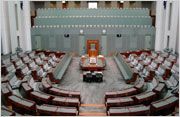Archived News for Health Sector Professionals
The Western Australian Government has launched a recruitment campaign to help address the lack of private general practitioners across the southern inland region of Western Australia.
The press and online campaign featuring local doctors working in the region will run nationally as well as internationally in countries, including Canada, the United Kingdom and New Zealand, where the medical training is recognised by the Australian Medical Council’s Competent Authority Pathway.
Health Minister Kim Hames said the recruitment drive was part of the $565 million Southern Inland Health Initiative, funded under the Liberal-National Government’s Royalties for Regions Program.
“A key focus of the first year will be to significantly increase the number of private GPs working in the area - which stretches from Kalbarri and Meekatharra in the north, to Laverton in the east, down to Esperance in the south-east,” Dr Hames said.
“The initiative will fund the equivalent work value of more than 40 doctors to secure emergency department and GP services in areas where GP recruitment is an ongoing challenge.
“This includes a $240 million investment in the health workforce as well as $325 million for capital works over the next five years.”
The Southern Inland Health Initiative has six activity streams to significantly boost health services to the region.
These include:
- $182.9 million District Medical Workforce Investment Program to improve medical resources and 24-hour emergency response across the districts;
- $147.4 million District Hospital and Health Services Investment program will provide major upgrades at six district hospitals. Funding will redevelop and enhance the campuses at Northam, Narrogin, Merredin, Katanning, Manjimup (Warren Hospital) and Collie. Recurrent funding of $26million will also be provided to boost primary health care services across each district;
- $43.4 million Primary Health Care Demonstration Program will provide communities with the opportunity to re-examine how their health services are delivered. Funding will be made available to improve primary health services for communities that opt in:
- $36.5 million Telehealth Investment will introduce innovative ‘e’ technology and the increased use of Telehealth technology across the region, including equipment upgrades;
- $20 million Residential Aged Care and Dementia Investment Program will provide incentive for private providers to expand options for residential aged care and dementia care;
- The Small Hospital and Nursing Post Refurbishment Program will provide $108.8million for capital works programs for small hospitals and nursing posts to be refurbished or, if required, rebuilt to enable delivery of contemporary health care services that will match the needs of the respective communities.
New members appointed to WA Ministerial Council for Suicide Prevention
The Western Australian Government has announced the appointment of new members to the Ministerial Council for Suicide Prevention to implement Western Australia’s first Suicide Prevention Strategy.
More funding urgently needed for new aged care nurses
The Australian Nursing Federation (ANF) has called for an injection of almost $500 million to close the wages gap and attract 20,000 new nursing staff.
Funding to combat Hendra
The Federal Government has announced a $6 million spending package to combat the Hendra virus.
Federal Government finalises health reform
The Federal Government has signed off with all states and territories on details of the national health reform, agreed to in principle by COAG in February.
Needle-free vaccination commercialised
Needless vaccination technology developed by the University of Queensland is due to be commercialised under funding by the Federal Government’s Innovation Investment Fund.
NSW Committee to develop Health and Medical Research Strategy
The Minister for Health and Medical Research, Jillian Skinner, has delivered on her pre-election promise to make medical research a priority by announcing the team which will develop the state’s first long-term plan to future-proof the industry.
Tasmanian Government details health spending cuts
The Tasmanian Minister for Health, Michelle O’Byrne has outlined a number of spending cuts to the state’s health sector, following the austere state budget that called for over $100 million to be pulled from state’s health system.
Report finds room for improvement in children's health
The Australian Institute of Health and Welfare (AIHW) has reported that while the health of children is generally faring well across the country, there is room for significant improvement in several areas.
AIHW publishes drug report
The Australian Institute of Health and Welfare has released the 2010 National Drug Strategy Household Survey Report, finding a mixed result for the consumption rates of smoking, alcohol and illicit drug use.
Funding awarded to develop virtual planning system for mental health
One of the most advanced virtual reality simulations ever applied to an Australian health care system is set to shape the future of mental health services.
New glandular fever, genes and MS link
Scientists working on the Australian-based Ausimmune Study have discovered that a past infection with glandular fever, also known as the Epstein-Barr virus (EBV), combined with genetic variations in the immune system can greatly increase a person’s risk of developing multiple sclerosis (MS).
Researcher receives leading NSW cancer research award
Achieving significant advances in the study of cancer cells and their ability to reproduce has seen University of Sydney researcher, Professor Roger Reddel awarded the Outstanding Cancer Researcher of the Year at the Cancer Institute NSW Premier's Awards for Outstanding Cancer Research.
New Centre for Nanomedicine launched
A new nanomedicine centre at the University of New South Wales, the first of its kind in Australia, will research new treatments for difficult-to-treat diseases including aggressive childhood cancer and lung cancer.
The Australian Centre for Nanomedicine (ACN), was launched by Australia’s Chief Scientist, Professor Ian Chubb. The centre brings together medical and clinical researchers with specialists in nanotechnology, engineering and chemistry to create new treatments for disease.
Professor Chubb said work like the ACN's was central to the purpose of Australia's universities.
"The purpose of universities is to use our talents to make the world a better place," Professor Chubb said.
"Nanomedicine will enable better delivery of drugs and vital therapies to individuals who would not prosper without that treatment."
The ACN, in partnership with the Children’s Cancer Institute Australia (CCIA) and UNSW’s Lowy Cancer Research Centre, is targeting neuroblastoma among its initial projects. Neuroblastoma is a difficult-to-treat cancer – the most common tumour in children under five years of age and one which has one of the lowest survival rates – 40 to 50 per cent.
University of Queensland to install Australia's most powerful MRI
The University of Queensland (UQ) has entered into a landmark agreement with technology specialist Siemens, to install a powerful MRI system that is more than twice as strong as any other system currently available in the Southern Hemisphere.
Queensland continues to recover health overpayments
The Queensland Government has continued to chase down overpayments to health workers, despite an agreement made between the Government and the Queensland Nurses Union to focus on the underpayment of staff throughout the state.
Pharmaceuticals accuse Government of reneging on deal
Representatives of some of the largest pharmaceutical companies have accused the Federal Government of reneging on a deal in which they accepted to charge less for their product in return for policy stability.
Victoria boosts funding for Medical Research Commercialisation Fund
The Victorian Government is providing funding of $1.6 million to support the operation of the Medical Research Commercialisation Fund over the next four years.
Studies show diabetic eye damage can be averted
Two studies conducted by the University of Western Australia show that early detection of diabetic retinopathy, swelling of the retina caused by diabetes mellitus, can significantly reduce its severity.
New appointments to Australian Institute of Health and Welfare
Former New South Wales Deputy Premier, Treasurer and Health Minister, Dr Andrew Refshauge has been appointed as the new Chair of the Australian Institute of Health and Welfare (AIHW) for a three-year term.
He will replace the outgoing Chair, Peter Collins.
Acting Minister for Health and Ageing Mark Butler also announced the appointment of three new members of the AIHW board—Mr James Moore, Ms Samantha Page and Ms Jessica Cumming.
NSW invests $30 million in cancer research
The New South Wales Minister for Health and Minister for Medical Research, Jillian Skinner, has announced an investment of more than $30 million in cancer research projects across seven major NSW research centres.







